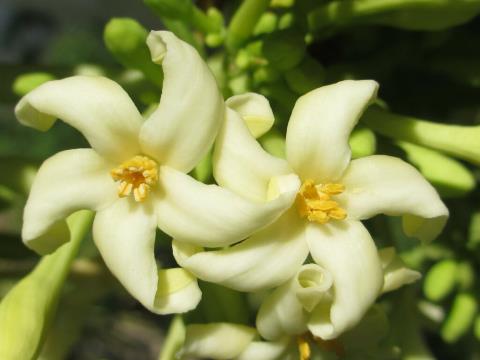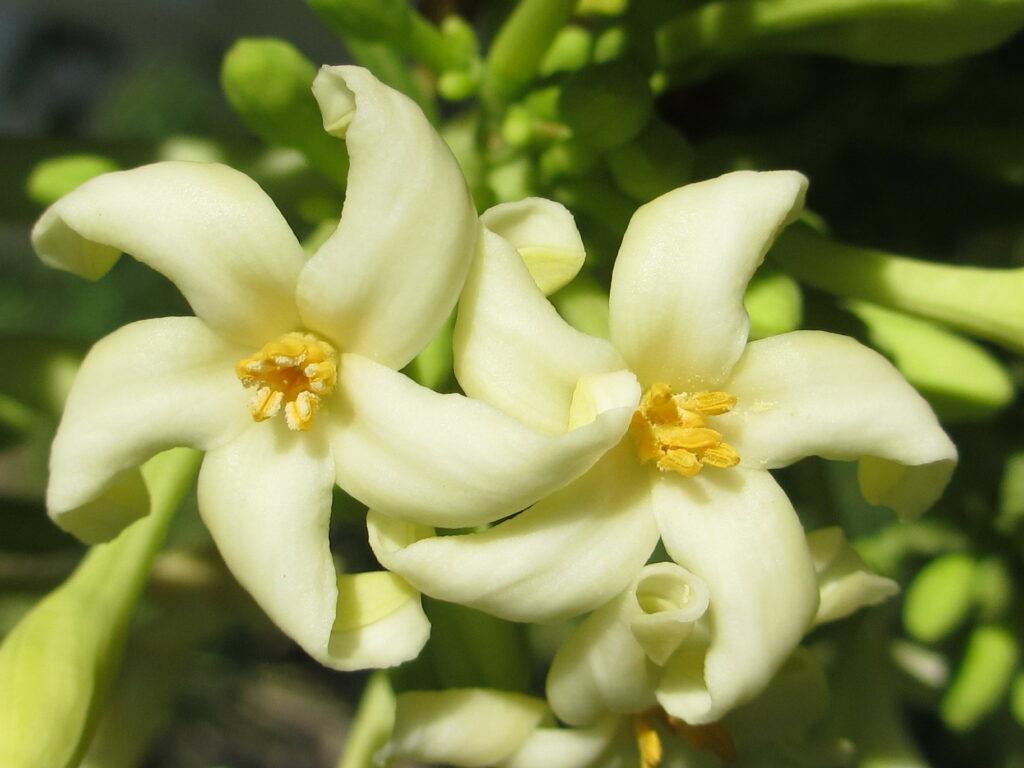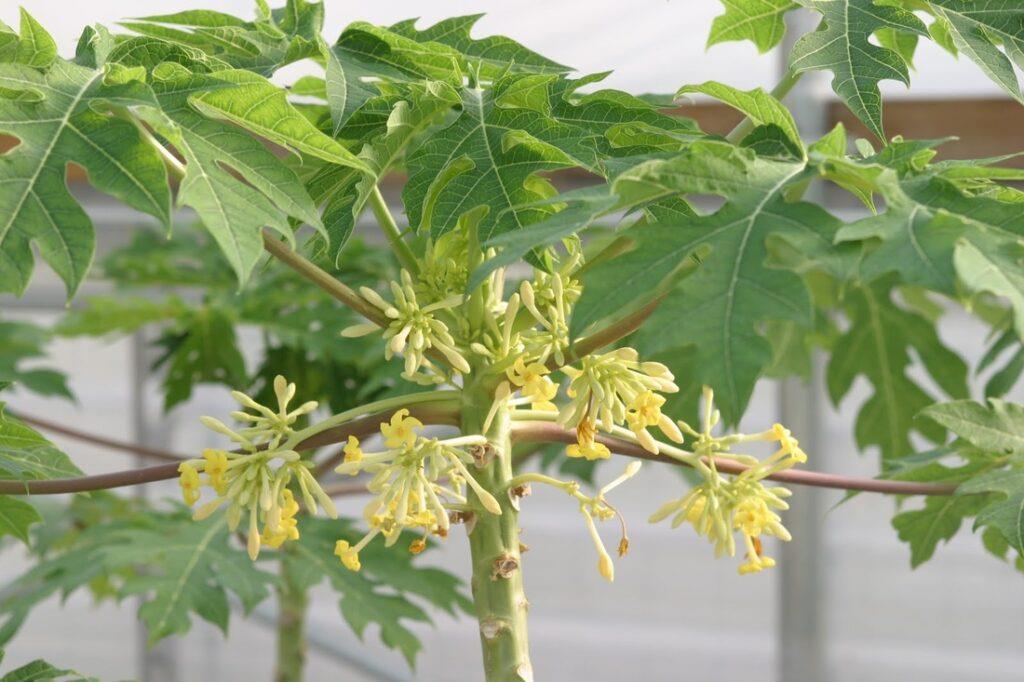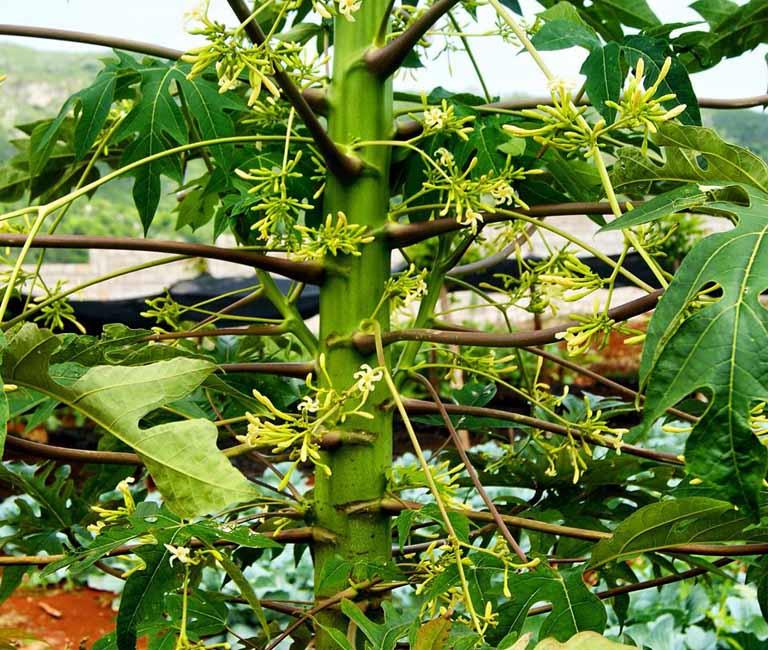Male papaya flower – the flower of the “discarded” plant and the truth of its effects

Papaya is a common tree, growing fruit. Due to the inability to produce edible fruit, male papaya trees are often uprooted. However, male papaya flowers are rumored to have many effects in the treatment of cancer, hypertension, diabetes, ... Let's learn about male papaya flowers and the truth about its effects through the following article. .
content
- 1. Introduction to Papaya tree
- 2. Place of distribution and cultivation
- 3. Uses of ingredients from Papaya
- 4. How to distinguish male and female papaya plants?
- 5. Chemical composition of male papaya flower
- 6. What are the effects of male papaya flowers?
- 7. Experience using male papaya flowers
- 8. Note
1. Introduction to Papaya tree
The papaya tree has the scientific name Carica papaya , belongs to the Papaya family. It is a large herbaceous plant, with little or no branches, 3–10 m tall. The bark bears many scars of the petiole.
The leaves are large, propeller-shaped, with long stalks, 50–70 cm in diameter, with about 7 notches. Flowers white or blue, small calyx, large five-petaled rim. The male flowers grow in the axils of the leaves and have very long stalks. The female flowers have corolla longer than the male flower corolla, learning into panicles in the interstitium of the leaves.

White or green papaya flowers, small calyx, large five-petaled rim
Papaya fruit is round, long, soft when ripe, the seeds are brown or black depending on the variety, with many seeds. The fruit is thick, green at first, then orange. In the fruit, there are many black seeds the size of pepper around with a layer of mucus.
2. Place of distribution and cultivation
Papaya is a plant that is native to tropical America. It was probably brought to the Philippines by the Spaniards around 1550. From there it was introduced into tropical Asia and Africa. Today, papaya is grown in most tropical countries such as Brazil, India, South Africa, Sri Lanka, the Philippines, and Vietnam.
Usually planted by seeds, it can be sown and then hit the seedlings to another place or planted on the spot. Dig holes, each hole sow 3-4 seeds. After planting 8-10 months start to harvest. Harvest the most from the 3rd year.
3. Uses of ingredients from Papaya
Papayas are often eaten green as a vegetable (for salads and stews) and cooked as a fruit. In papaya fruit, there is an enzyme called papain, a protease that softens meat and other proteins, so green papaya is often stewed with meat to help it soften quickly.
The Papaya plant provides many medicinal parts: green and ripe papaya fruit, papaya seeds, papaya flowers, papaya sap, papain and cacpain.
4. How to distinguish male and female papaya plants?
Papaya is a calculus plant. Female papaya plants flower and bear fruit, while male enough plants often do not.

Male papaya trees are often abandoned due to failure to harvest the fruit
The trunk of the papaya tree is usually large, the base of the tree is slightly tilted. Flowers grow close to the stem, large and not in clusters. The more papaya flowers, the higher the fruit set rate. The female papaya seeds are darker in color and more succulent. As for young trees, the roots of female papaya trees grow in the form of large, strong roots.
In contrast, the male papaya has a rather small body compared to the female papaya. Male papaya flowers grow in the interstitial part of the leaves, have long branches, many flowers and grow in clusters. Male papaya produces a lot of flowers and usually few fruits, if any, the fruit is very small or not good to eat. Seeds soaked in water will usually float on water, have a light white color, not the glossy black color like female papaya seeds. As for young plants, the roots are the type of stake roots, growing deep into the soil.
5. Chemical composition of male papaya flower
5.1. Inorganic ingredients
It is found that male papaya flowers contain macro- and micro-elements: Potassium (K), Sodium (Na), Manganese (Mn), Magnesium (Mg), Iron (Fe), Zinc (Zn), Copper ( Cu), Calcium (Ca), … in different proportions.
In particular, potassium is an essential nutrient, it helps in the metabolism of proteins and carbohydrates. Sodium is essential in regulating the body's osmotic pressure and aids in maintaining acid-base balance and water balance in the body.
Magnesium deficiency can affect almost any organ system of the human body. The calcium content in the flower gives a value of 9.32 mg/g. Calcium is needed for healthy teeth, bones and blood. The calcium content in the flowers suggests the possibility of their use to treat calcium deficiency disease.
Zinc and Iron are micronutrients for living organisms. Zinc is needed for healthy nails and metabolic processes. Iron is needed for hematopoiesis. It binds with hemoglobin in the body to help carry oxygen from the lungs to the tissues.

Male papaya flowers contain: Potassium (K), Sodium (Na), Manganese (Mn), Magnesium (Mg), Iron (Fe), Zinc (Zn), Copper (Cu), Calcium (Ca), ... with the ratio different
5.2. Organic ingredients
Folic acid was found in male papaya flowers with a high concentration of 510.34 mg/100 g dry weight. Folic acid or vitamin B9 is an essential vitamin, needed for many body metabolisms.
The flower also contains phenolic compounds such as caffeic acid, gentisic acid, m-coumaric acid, p-coumaric acid, salicylic acid and quercetin. There are also alkaloids and saponins.
Sufficient flower extracts have antioxidant activity through DPPH free radical inhibition. At the same time, it also has antibacterial effects , against two pathogenic bacteria , Escherichia coli and Bacillus subtilis.
6. What are the effects of male papaya flowers?
Many components from papaya such as leaves, stalks, stems, and flowers are believed to have anti-cancer effects. This opinion is based on cell studies. As for male papaya flowers, a 2015 study showed that ethanol extracts and male papaya flowers were cytotoxic on the MCF-7 (breast cancer) cell line.
>> See also: Early warning signs of breast cancer that women should know
In contrast, the study of the authors in Ho Chi Minh City, analyzed the effect of male papaya flowers collected in Binh Dinh. The results showed that the male papaya flower extract was unable to inhibit the four human cancer cell lines used in the trial. They are MCF-7 (breast carcinoma), HeLa (cervical cancer), Hep-G2 (hepatocellular carcinoma), and NCI-H460 (lung carcinoma).
Contrasting research results indicate that its anti-cancer effects have not been specifically demonstrated.

Many components from papaya such as leaves, stalks, stems, and flowers are believed to have anti-cancer effects.
7. Experience using male papaya flowers
According to experience, male papaya flowers are used to treat jaundice, cough, hoarseness, bronchitis, laryngitis and tracheitis .
Fresh or dried male papaya flowers, steamed with sugar or rock sugar. Drink to treat cough, laryngitis, loss of voice.
8. Note
- Pregnant women, lactating mothers and children under 3 years old absolutely should not use because papain extract in papaya causes miscarriage in animals. High doses of papain in papaya can be toxic to an unborn baby.
- People with cold or cold stomach and diarrhea should not use it.
Male papaya flower is a medicinal herb used to treat respiratory diseases such as cough, laryngitis, etc. Although its anti-cancer, antihypertensive, antidiabetic, ... . However, with its content of beneficial substances, vitamins and minerals, male papaya flowers can be produced as a nutritional supplement tea.